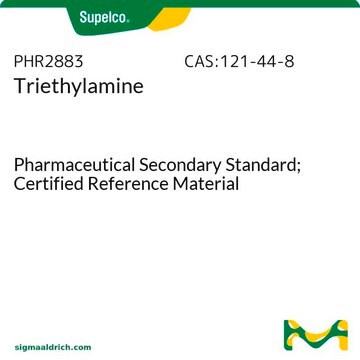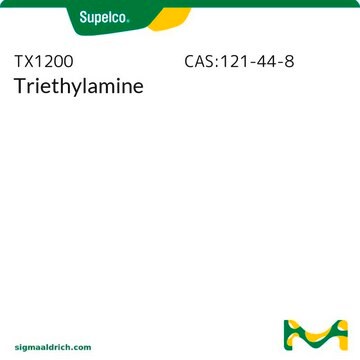73487
Triéthylamine
analytical standard
Synonyme(s) :
N,N-Diéthyléthanamine
About This Item
Produits recommandés
Qualité
analytical standard
Niveau de qualité
Densité de vapeur
3.5 (vs air)
Pression de vapeur
51.75 mmHg ( 20 °C)
Pureté
≥99.5% (GC)
Température d'inflammation spontanée
593 °F
Durée de conservation
limited shelf life, expiry date on the label
Limite d'explosivité
8 %
Technique(s)
HPLC: suitable
gas chromatography (GC): suitable
Impuretés
≤0.5% water
Indice de réfraction
n20/D 1.400-1.402
n20/D 1.401 (lit.)
Point d'ébullition
88.8 °C (lit.)
Pf
−115 °C (lit.)
Densité
0.726 g/mL at 25 °C (lit.)
Application(s)
cleaning products
cosmetics
flavors and fragrances
food and beverages
personal care
Format
neat
Chaîne SMILES
CCN(CC)CC
InChI
1S/C6H15N/c1-4-7(5-2)6-3/h4-6H2,1-3H3
Clé InChI
ZMANZCXQSJIPKH-UHFFFAOYSA-N
Vous recherchez des produits similaires ? Visite Guide de comparaison des produits
Catégories apparentées
Description générale
Application
- Food and beverages using ion-exchange chromatography with conductivity detection.
- Smoke flavoring from rice husk using gas chromatography coupled to mass spectrometric detection, flame ionization detection and olfactometry analysis (GC-O).
Mention d'avertissement
Danger
Mentions de danger
Classification des risques
Acute Tox. 3 Dermal - Acute Tox. 3 Inhalation - Acute Tox. 4 Oral - Eye Dam. 1 - Flam. Liq. 2 - Skin Corr. 1A - STOT SE 3
Organes cibles
Respiratory system
Code de la classe de stockage
3 - Flammable liquids
Classe de danger pour l'eau (WGK)
WGK 1
Point d'éclair (°F)
12.2 °F - closed cup
Point d'éclair (°C)
-11 °C - closed cup
Faites votre choix parmi les versions les plus récentes :
Déjà en possession de ce produit ?
Retrouvez la documentation relative aux produits que vous avez récemment achetés dans la Bibliothèque de documents.
Les clients ont également consulté
Notre équipe de scientifiques dispose d'une expérience dans tous les secteurs de la recherche, notamment en sciences de la vie, science des matériaux, synthèse chimique, chromatographie, analyse et dans de nombreux autres domaines..
Contacter notre Service technique











